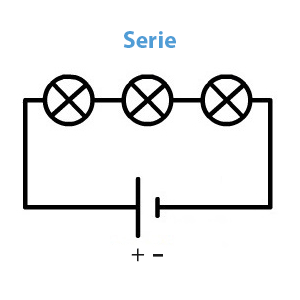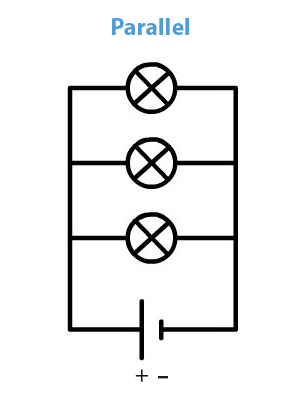In our daily lives, lighting has become taken for granted. We press a switch and expect the light to come on. But behind this simple act lies a world of electrical switching. In this blog, we dive deeper into the two most common ways in which lighting is switched: in series and parallel.
Parallel and series circuits of LED spots
More than one LED spotlight is usually installed in a room. In most cases, it is not feasible to provide each spotlight with its own connection point, such as a plug and socket. In that case, you come up against parallel and series connection.
What is a series circuit?
In the case of a series circuit, all the spotlights are connected to a single circuit, acting as a connected chain. The electric current from the power source starts at the positive terminal of the first lamp, then passes through the negative terminal, and then continues to the next lamp to complete the circuit. If one bulb in the series circuit fails, the circuit is interrupted and the electricity cannot continue to flow, causing all the spotlights to fail. A good example of this is Christmas tree lighting.

The advantages of a series connection
1. Series-connected circuits are easier to connect and require less wiring.
2. Because less wiring and switches are required, series-connected systems can be cost-effective.
The disadvantages of a series circuit
1. Series-connected systems are vulnerable to a single component failure. If one spotlight fails, the whole series goes out.
What is a parallel circuit?
In a parallel circuit, you loop the LED spots in multiple circuits through to the power supply. You connect both the positive and negative terminals together, giving electricity the freedom to flow through different circuits. As a result, the failure of one broken spotlight will not affect the functionality of the others, so they will still remain lit.

Advantages of parallel-connected lighting
1. Parallel-connected circuits are safer because a single failure in one lamp does not affect the rest of the lighting.
2. You can switch individual lamps on and off without affecting the others, allowing you to customise the lighting to your needs.
3. Parallel circuits are generally more reliable because of their ability to isolate individual components.
Disadvantages of parallel-connected lighting
1. Parallel circuits require more wiring and switches, which may lead to higher installation costs.
2. Replacing a faulty spotlight may require more effort.
The right choice for the right application
Whether to use series- or parallel-switched lighting depends on the specific application and desired functionality. For general household lighting and commercial applications, parallel-switched lighting is usually the best choice because of the safety and flexibility it offers. However, series-switched lighting is still relevant for specific situations where easy operation and lower costs are important.
Both circuits at Hamulight
Hamulight sells both parallel and series switched lighting. We sell porch lighting in set form, where the spotlights operate on a series or parallel transformer. The sets that are series-connected can be recognised by the white connector on the transformer. The parallel sets have a black connector.
The garden lighting range consists of 230-volt and 24-volt lighting. Both systems are connected in parallel.
The LED spots that serve as indoor lighting are powered by a small transformer. This transformer ensures that the spots are switched in parallel.
Need help?
After reading this blog, don't know how to connect the spots? Then feel free to contact us. We will be happy to explain our systems to you so that your lighting works properly!





